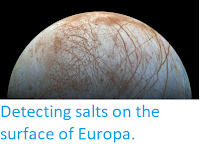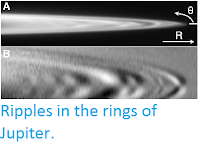Europa is the fourth largest moon of Jupiter, and the fifteenth largest
body in the solar system. It was one of the four moons discovered by Galileo Galilei
in 1610. It has long been thought that Jupiter's icy moon Europa has an
ocean
beneath its surface, kept liquid by the heat generated by the tidal
forces excerpted by Jupiter's gravity, and that this may possibly be as
much as 160 km deep, on a moon with a radius of slightly under 1600 km. A
possible subterranean sea of Europa is considered the most likely place
to look for non-terrestrial life in our Solar System, but the
likelihood of life being found there depends very much on the chemical
composition of that ocean.
An artist's impression of structure of Europa, with a frozen surface, a shallow lake beneath a chaos terrain, and a deeper ocean. Britney Schmidt/Dead Pixel VFX/University of Texas at Austin.
It has been theorised that the continuous bombardment of the surface of Europa by high energy particles should result in the splitting of water molecules into hydrogen and oxygen ions, and furthermore that the hydrogen ions would most probably be lost into space, while the oxygen ions recombine with other water molecules in the ice to form hydrogen peroxide (H₂O₂). Over time this hydrogen peroxide could build up, and potentially act as a means of delivering oxygen to the subsurface ocean.
The Galileo Near-Infrared Mapping Spectrometer was able to detect hydrogen peroxide on the leading/anti-Jovian quadrant of Europa (Europa, like our Moon, is tidally locked, so that it always has one face
pointing towards Jupiter; this also means that one side of the moon is
always facing forwards, in the direction of movement, the Leading
Hemisphere, and one always faces back, the Trailing Hemisphere), which
is thought to be bombarded by magnetic clouds of sulphur ions
originating from volcanic eruptions on Io, which move outwards (away
from Jupiter), but the intense radiation encountered during closer flybys of Europa hampered the working of the instrument, preventing the operators from mapping the location of the hydrogen peroxide.
In a paper published on the arXiv database at Cornell University
Library on 2 August 2019, and in The Astronomical Journal on 27 August 2019, Samantha Trumbo and Michael Brown of the Division of Geological and Planetary Sciences at the California Institute of Technology, and Kevin Hand
of the Jet Propulsion Laboratory also at the California Institute of
Technology, describe the results of a spectographic study of Europa made using the near-infrared spectrometer NIRSPEC on the Keck II telescope on Hawaii’s Maunakea volcano.
Molecules will absorb light as energy across a broad part of the spectrum, but can only absorb a finite amount of light before being forced to re-emit some of this energy. However this energy is not released in random bursts, but radiated at specific frequencies determined by the atoms present in the molecule, which atoms are bound to which other atoms, and even which isotopes of each element are present. This gives each molecule its own unique spectrographic signature, which can be used by astronomers to detect different molecules in distant objects such as the surface of the Jovian moons.
Trumbo et al. observed Europa on 24-25 February 2016 and 6 June 2018. During both sets of observations, Europa had an angular diameter of nearly 1 arc second (the sky, imagined as a globe, is
divided into 360 degrees, each of which is divided into 60 arcminutes, with
each arc minute being further divided into 60 arcseconds), corresponding to ten 300 km resolution elements at the di raction limit of Keck at 3.5 μ m. For each Europa observation, Trumbo et al. aligned the slit in either an east/west or north/south orientation with respect to Europa's north pole.
The 2016 data show generally stronger absorptions than do the 2018 data, with maximum band areas 25% larger than those observed in 2018. This is perhaps unsurprising given that H₂O₂ concentrations on Europa reflect a dynamic equilibrium between constant formation and decay that may be influenced by the temporal variability of the radiation environment or of the local surface temperature.
H₂O₂ was predicted to be concentrated in the coldest, iciest parts of the surface of Europa, where it should in theory have the longest residence time, as it decays into water and oxygen more rapidly at higher temperatures, but instead it was found to be concentrated in the relatively warm chaos terrains (areas that show surface disruption, with sections of what appear to be shattered crust locked in smoother areas of ice, resembling icebergs caught in frozen sea-ice) close to the moon's equator. Trumbo et al. suggest that this may be related to the presence of salt (sodium chloride) in these terrains, which may help to delay the decay of H₂O₂, though they could find no experimental data on the way in which salt effects this decay.
An artist's impression of a chaos terrain on Europa. NASA.
See also...
Follow Sciency Thoughts on Facebook.









